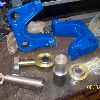My 98 4.0 SOHC is really fast. Are they supposed to be fast? I have whipped up on a lot of cars and trucks trying to race me.
Seems like the thing has endless gears compaired to my 4.0 95 EB and my 01 Expedition 5.4.
I hit the gas and it starts going into passing gear, but if I hit it again it goes into a higher passing gear and just kicks azz is this normal or did someone put a tune on this thing?
I know it is all set up for towing and the towing rack in the back is huge and meant for hauling something big and the it even had what looks like after market oil and trans coolers.
Anyone have any ideas? I got this truck used.
Seems like the thing has endless gears compaired to my 4.0 95 EB and my 01 Expedition 5.4.
I hit the gas and it starts going into passing gear, but if I hit it again it goes into a higher passing gear and just kicks azz is this normal or did someone put a tune on this thing?
I know it is all set up for towing and the towing rack in the back is huge and meant for hauling something big and the it even had what looks like after market oil and trans coolers.
Anyone have any ideas? I got this truck used.










